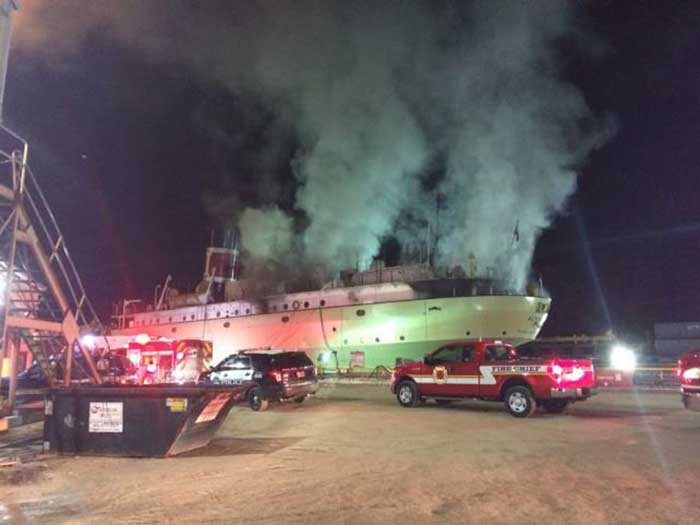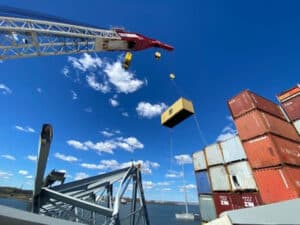
Ship caught fire in dry dock due to electrical fault
Written by Nick Blenkey
Sturgeon Bay Fire Dept responded to fire
NOVEMBER 15, 2016 — A National Transportation Safety Board Report finds that the probable cause of a fire that broke out December 11, 2015 on a 1942-built Great Lakes steamship while in dry dock was an electrical fault and was not associated with the ongoing shipyard work or with any of the daily work being attended to by the ship’s crew living aboard.
According to the NTSB report, the fire aboard the ship, the Alpena, broke out about 1740 local time in the electrical control room for the aft winches while the ship was drydocked at Fincantieri Bay Shipbuilding, Sturgeon Bay, WI.
Shipyard workers evacuated the vessel and notified the local fire department, which extinguished the fire.
No one was injured, but the Alpena sustained nearly $4 million in damage.
By 1903 local time, the fire was under control, and by 0117, all spaces were fully cleared. In total, more than 80 firefighters responded to the accident. The Sturgeon Bay fire chief restricted access to the aft section of the vessel to preserve the scene for subsequent investigation into the cause of the fire.
Access to the fire-affected spaces was not authorized until December 15, 2015, because atmospheric readings for lead and asbestos were considered too high for entry. Until asbestos remediation could be undertaken, entry into the galley and accommodation spaces required a respirator.
The NTSB report says that, based on both the Coast Guard and fire department investigations, the most likely cause of the fire was an electrical fault in the wiring from the electrical control panel to the aft winch.
The electrical system for the aft winch was original to the vessel and complied with regulations for original equipment; however, it did not have the more extensive circuit protection that modern shipboard electrical systems have. (According to the Coast Guard, planned post-accident modifications to the Alpena would feature additional circuit protection in accordance with current regulations.)
The power cable to the aft winch was completely melted for a length of 10–15 feet. Similar conductors in the same wiring bundle were not damaged, which led investigators to believe that this specific conductor experienced a fault of some kind rather than being destroyed by the heat of the ensuing fire.
As further evidence to support this conclusion, the same cable’s sheathing and insulation had signs of significant deterioration on the boat deck, several decks above where the fire started, where the aft winch is located. This area of the vessel was not affected by the fire.
Read the report HERE





Leave a Reply
You must be logged in to post a comment.